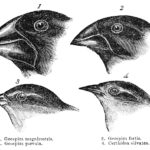Do you know anyone who has red hair? How about brown, black, or blonde hair? What other colors can you think of? There are literally hundreds of different shades of hair color that a person can have. Color is not the only characteristic of hair that helps determine how someone looks. How thick is your hair? Is it curly or straight? Do you have cowlicks?
With all the possible variations, it would be very difficult to find two people with the exact same hair color, thickness, and so on. What about your eyes. What color are they? How big are they? Are they set deep in your head, or do they bulge outward?
Yet, despite the fact that your friends and family all look very different from one another, it is still quite easy for us to tell them apart from dogs, cats, and apricot trees. What determines how someone will look? What insures that all humans look like humans, yet also still look very different from one another? This force is called genetics.
History of Genetics
Throughout most of human history, the reason why an organism looks like its parents, while looking very different than a hound dog (unless its parents were hound dogs), was not known.
This changed in the 1860s, when an Austrian monk by the name of Gregor Mendel began experimenting with peas. Mr. Mendel wanted to find out how lifeforms pass physical characteristics, also known as traits, from one generation to the next.
The traits that Gregor Mendel focused his study on were the height of a pea plant, the color of pea seeds, and the shape of pea seeds. By cross pollinating the pea plants, he carefully controlled which plants reproduced, and tracked how each of these traits was passed on from generation to generation. Cross pollination means that Gregor Mendel took pollination from a pea plant which he selected and put it on another pea plant he selected.
Gregor Mendel’s Experiment
To better understand what Mendel learned, let’s explore height, which is one of the pea traits that he experimented with.
In his early experiments, Mendel took pollen from short stemmed pea plants and put it on other short stemmed pea plants. The result, as you might expect, is that all the offspring were all short stemmed pea plants. Mendel called these true breeders, because all the offspring were the same as the parents.
He then took pollen from long stemmed pea plants and put it on other long stemmed pea plants. What do you thing the result was? If you guessed that all the offspring would also be long stemmed, then you made the same guess as Gregor Mendel. Interestingly, this was not the result. Some of the long stemmed parent plants produced only tall offspring, as you would expect. However, some of the long stemmed pea plants also produced short stemmed offspring. How can this be?
Gregor Mendel discovered that some of the tall pea plants were true breeders, meaning that they only produced other tall pea plants, while others of the tall plants were not true breeders, because they produced a mixed offspring of both tall and short plants.
Next, Mendel took the pollen from true breeding tall pea plants and put it on true breeding short plants. He called these true breeding parent plants the P1 generation. He wanted to find out which trait would be passed to the offspring, the trait for being tall, or the trait for being short. What do you think happened?
To his surprise, all of the offspring were tall. Mendel called this second generation of plants the F1 generation. The trait for short stemmed plants seemed to have simply disappeared. Finally, Gregor Mendel took pollen from this F1 generation of pea plants, and put it on other pea plants in the same F1 generation. What do you think happened?
Amazingly, the short stemmed trait reappeared. Some of the offspring were short.
Gregor Mendel realized something very important. He realized that every plant had not one, but two genes for each trait. This meant that every pea plant could have two tall genes, two short genes, or a tall and a short gene.
If a plant inherited two tall genes, how do you think it would grow? Well, there is no short gene, so the plant will grow to become a tall plant. What if a plant has two short genes? Because there is no tall gene, the plant will be short. But what will happen if a plant has both a tall gene and a short gene?
Mendel discovered that some genes are dominant, or stronger than other genes. When there are two different kinds of genes (a tall and a short) the dominant gene will determine how the plant will grow. In pea plants, the tall gene is dominant, while the short gene is recessive. Recessive is a big word that means “not dominant.”
This means that if a pea plant has both a tall gene, and a short gene, the tall gene, which is dominate will make the plant grow tall. The short gene is still there, and can still be passed on to future generations of plants.
Gregor Mendel developed a hypothesis about how genes are passed from parents to their offspring. This hypothesis, which scientists still use today, says that a pea plant (And all other life forms) have two genes, for tallness, making a gene pair. They also have a gene pair for every other trait, including seed shape, seed color, or in humans, eye color, hair color skin color, etc.
How This Applies To You And I
When reproducing, each parent can pass only one gene to their offspring, from each gene pair. This means that the offspring will inherit one gene from each parent, making a new gene pair.
This means that if your father has two genes for brown hair, and your mother has two genes for blonde hair, what will you inherit? You will receive one brown hair gene from your father, and one blonde hair gene from your mother. Your gene pair for hair color will be brown – blonde.
Scientists write gene pairs by using capital and lowercase letters. (TT, Tt, tt) The capital letter represents a dominant gene, while the lower case letter indicates a recessive gene.
Now, let’s return to our discussion about pea plants. In Mendel’s experiments, he put the pollen from true breeding tall pea plants (TT) on true breeding short (tt) pea plants. Remember, each parent can only pass one gene to the offspring. What will the gene pair look like for the offspring? They will all be (Tt), having one tall gene and one short gene.
Next, he took the pollen from these plants (Tt) and put it on other (Tt) plants. What will the offspring’s gene pair look like? This is a bit more tricky isn’t it. Some of the plants will inherit a (T) from the mother plant and a (T) from the father plant. Some of the offspring will inherit a (t) from the mother and a (T) from the father. Some will inherit a (T) from the mother and a (t) from the father. And some will inherit a (t) from the mother and a (t) from the father.
All the (TT), (Tt), and (tT) plants will be tall. This is because the (T) is dominant. The (tt) plants will be short because there is no dominant (T) to make them grow tall. As a result, three out of every four, or 75% of the offspring will be tall, while one out of four, or 25%, will be short.
Incomplete Dominance
So far, we have seen that a gene pair is made up of two genes inherited from the parents of a living thing. We have seen that a dominant gene will mask, or hide the traits of a recessive gene.
Most gene pairs have a dominant and a recessive gene. But not always. Sometimes, instead of one gene dominating another, the genes produce a mixed result. A good example of this is with the Four o’clock flower.
If you mix a red (RR) flower with a white (WW) flower, what will the offspring’s gene pair look like? If you said (RW) you are correct. What color with the flower be? Neither the red nor the white is dominant. Instead, the result is a mixed pink flower.






